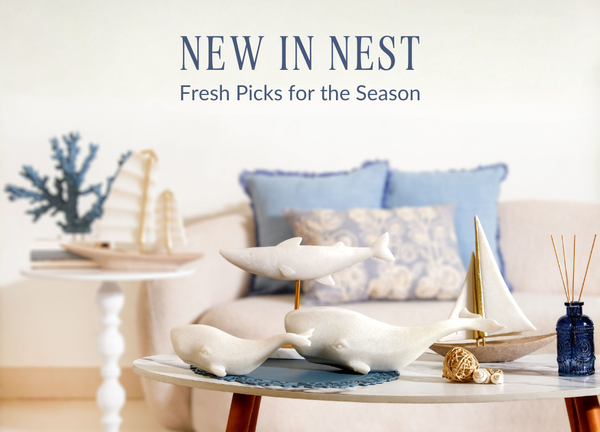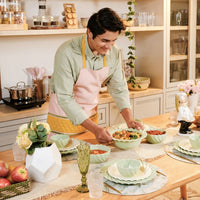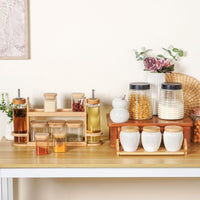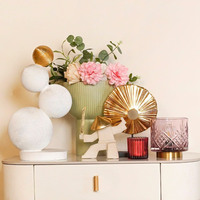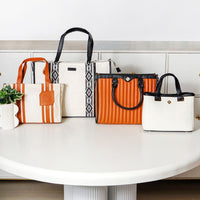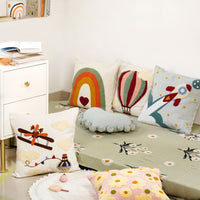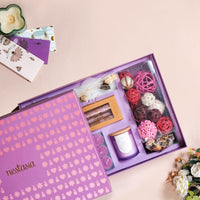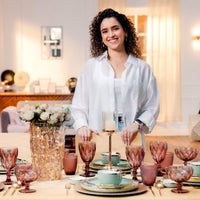When it comes to decorating your house, it’s more than adding expensive pieces of furniture, door frames, or sophisticated decor items. The beauty of one’s house is reflected when everything seems well put and in perfect synchronization with one another. A lot of us concentrate more on the colour coordination of our walls and ceilings, and often overlook the smaller elements that truly tie a space together, like curtains, sofa covers, and table linens!
Table linen plays a much bigger role than we often realize. Beyond just being functional, well-chosen table mats, runners, and fabrics can instantly add charm to your dining space, whether it’s a casual brunch at home or an elaborate festive gathering.
This blog explores the significance of styling with table linen and how it can transform your dining experience. From choosing the right materials to match various themes, to layering mats and runners with ease, and coordinating colors and patterns, we’ll guide you through creating the perfect blend of everyday charm and festive elegance.
Choosing the Right Material For Your Theme
The choice of fabric sets the foundation for your table setting, influencing not only the overall look but also the mood and theme of the space. Now let us try and understand how different materials reflect different aesthetics:
1. PU or PVC material:
As we all know that PU and PVC are synthetic, modern-day materials. Therefore, it goes without saying that tablemats of these materials are usually used for a modern aesthetic. PU (Polyurethane) and PVC (Polyvinyl Chloride) are versatile materials, known for durability, sleek finish, and ease of maintenance. These synthetic options are perfect for creating stylish table settings that are both functional and visually appealing.
With their water-resistant surfaces and wipe-clean convenience, they’re ideal for everyday use as well as casual gatherings. Whether you're hosting a quick brunch or a relaxed dinner, PU and PVC table mats and runners offer a modern aesthetic that complements minimalist interiors while making setup and cleanup effortless.
2. Sabai and Kauna material:
Scientifically known as Eulaliopsis binata, Sabai grass is a perennial plant native to India and other parts of Asia, particularly West Bengal and Odisha, where it plays a vital role in traditional handicrafts and supports the local economy. Characterized by its soft, slender leaves and sturdy, upright growth, Sabai grass is a natural fiber that can be dyed and is widely used to make durable, lightweight, and flexible woven products such as mats, baskets, and ropes.
Similarly, Kauna grass (Sacrodria griffithii), an aquatic plant found in the wetlands and riverbanks of India, Nepal, and Bangladesh, is highly valued for its long, pliable stems ideal for weaving. Especially prominent in the Indian states of Assam and Manipur, Kauna grass is crafted into beautifully intricate mats, floor coverings, and decorative items using traditional techniques passed down through generations.
 Both grasses are essential to their respective regions' craft traditions and economies, offering sustainable, eco-friendly materials for artisanal products that reflect rich cultural heritage and skilled craftsmanship.
Both grasses are essential to their respective regions' craft traditions and economies, offering sustainable, eco-friendly materials for artisanal products that reflect rich cultural heritage and skilled craftsmanship.
Since the Boho aesthetic is all about embracing a relaxed and worldly vibe that combines artisanal and natural elements in a creative, yet laid-back manner, using kauna or sabai mats reflects this very vibe. These mats, directly made from natural fibre, emphasize an appreciation for nature, organic textures, and environmentally conscious living, and embrace handmade, artisanal products.
Their earthy hues and handcrafted texture help soften modern or minimalistic spaces, adding depth and visual interest without overpowering the decor. In a boho setting, every detail matters, and something as simple as a grass mat can enhance the overall ambiance, making the dining experience feel more grounded and cozy. It’s this fusion of natural beauty, craftsmanship, and storytelling that makes Sabai and Kauna mats a perfect fit for boho-inspired dining.
If you’re planning a boho theme for your next hosting, our Rectangular Sabai Mat Natural along with Round Handwoven Organic Kitchen Baskets is perfect to challenge your inner bohemian!
3. Cotton:
No matter what the aesthetic is, no matter what the occasion is, cotton linen is always a classic and saves you from uncertainty because it never goes out of style. Cotton, as a natural fabric, has long been associated with traditional home decor due to its soft texture, durability, and versatility. When used in table settings, it brings a clean, crisp look that enhances the overall sophistication of the space without being overly ornate.
The best part of using cotton mats or table linens is the variety. They come in all shapes and patterns, starting from abstract designs, solid colours, neutral tones, refined stripes, and floral prints.
The understated charm of cotton also allows it to pair seamlessly with other classic elements such as fine china, polished silverware, and wooden or antique furniture. Its breathable and washable nature adds to its practicality, making it both beautiful and usable for daily or formal dining.
Layering Mats and Runners
Just like putting together the perfect outfit, styling a dining setting with layers takes a bit of thought. But don’t worry, in this section, we’ll walk you through the easiest and most effective ways to layer your dining table so you don’t have to stress. We’ve got you covered, besties!
The most important thing to take into consideration while layering is colour and pattern coordination. Layering is a simple yet effective way to add depth to your table. There are only a few elements that we need to layer our dining spaces-
1. A table cloth:
Choosing a tablecloth mindfully is very important because it sets the foundation for your entire dining setting. It’s the first layer that defines the tone and mood of the space, whether you’re aiming for a casual brunch vibe, a festive celebration, or an elegant dinner party. The colour, texture, and pattern of the tablecloth influence all the other elements that follow, starting from runners to dinnerware.
A neutral or solid-colored tablecloth offers a versatile canvas that allows other layers to shine, while a bold or patterned one can become the statement piece of your setup. Additionally, the fabric you choose matters too. Cotton lends a soft, classic feel; linen adds rustic elegance; and heavier fabrics like jacquard or damask bring in a sense of formality. By selecting your tablecloth with intention, you create a cohesive base that enhances every other detail on your table.
2. A table runner:
It is the second layer that adds structure and visual interest to your table setting. Placed along the center of the table, a runner can either complement or contrast with the tablecloth, depending on the mood you want to create.
For a cohesive look, choose a runner in a similar color family or with subtle patterns. For a bolder aesthetic, opt for contrasting colors or textures that stand out. The runner helps define the space for your centerpiece and can tie together the rest of your elements, such as placemats, dinnerware, and napkins, bringing depth and dimension to the overall setup.
3. Table mats:
Table mats are the third layering and can either match the tablecloth or the runner. They provide a designated space for each guest’s plate, protecting the tablecloth underneath from spills, heat, and scratches. But beyond practicality, table mats also play a key role in enhancing the overall look of the table. They can either match the tablecloth or the runner for a coordinated appearance, or they can introduce a new color, texture, or pattern to add contrast and visual interest.
For instance, woven mats like Sabai or Kauna grass bring a natural, earthy feel, while cotton or embroidered mats offer a softer, more refined touch. When chosen thoughtfully, table mats help tie the entire table setting together, adding depth, balance, and personality to the dining space. Whether you prefer a minimalist look or a more layered, eclectic style, the right table mats can elevate your table from simple to stunning.
4. Table Napkins:
The last step of setting up the perfect dining setup is adding table napkins, a small detail that makes a big impact. Though they may seem like a minor element, napkins bring everything together, adding the final touch of sophistication and refinement to your table setting. When chosen and folded thoughtfully, napkins elevate the overall aesthetic, turning a simple meal into a polished dining experience.
Napkins should work in harmony with the rest of the setup. If you’re using a neutral tablecloth or runner, napkins can introduce a pop of color or pattern, creating visual interest without overwhelming the space.
For example, if the tablecloth is a soft white or beige, consider napkins in a rich, deep color like navy, burgundy, or emerald green to add elegance. Alternatively, if your runner is bold or patterned, choose napkins in a solid, complementary colour to balance the design.
If you prefer a more cohesive and subtle approach, match the napkins to the table runner or placemats. This creates a seamless flow across the table, especially when the tablecloth is the standout feature. Textures also play a role in napkin selection. If the tablecloth is linen or cotton, consider choosing napkins in the same material to maintain consistency in texture.
For example, create a stunning dining look with an ivory linen tablecloth, paired with a gold runner for that perfect touch of warmth. Add earthy taupe mats and finish with rich burgundy napkins for a bold pop. This mix of soft neutrals and luxe accents makes for an effortlessly elegant table setting!
Watch our 8 Dinner Table Mistakes That Are Ruining Your Party Vibe video on YouTube to avoid mistakes while setting up the perfect dinner table and keep your guests in wonder!
Everyday vs festive styling ideas
1. Everyday:
-
Simple Linen Tablecloth: Opt for a crisp, neutral linen tablecloth that can be easily dressed up or down. Pair it with minimalistic tableware for a clean, casual look.
-
Natural Elements: Use woven mats or placemats made from materials like rattan or bamboo for an earthy, understated feel. Add a small potted plant as a centerpiece.
-
Subtle Color Palettes: Stick to soft, muted tones like beige, white, or light gray. Add color with napkins or glassware, keeping it relaxed and functional.
-
Casual Flatware & Glassware: Go for simple, everyday dinnerware - think ceramic plates and glasses in neutral tones or subtle patterns. Keep the silverware minimal and easy to clean.
-
No-Fuss Centerpiece: Use a small vase with fresh flowers or candles for a subtle but charming focal point. Keep the arrangement low to avoid clutter.
Shop Now
2. Festive Styling Ideas:
-
Bold Tablecloth & Runner Combo: Choose a luxurious fabric like velvet or jacquard for the tablecloth and a statement runner with rich patterns or metallic accents to set the festive mood.
-
Elegant Centerpiece: Create a striking centerpiece with a mix of candles, flowers, or even a decorative bowl filled with seasonal fruits or ornaments to make the table pop.
-
Vibrant Colors: Use rich, festive colors like deep red, gold, emerald green, or navy blue. Pair them with elegant, coordinated napkins, placemats, and tableware for a celebratory vibe.
-
Fine China & Glassware: Upgrade your everyday dishes with fine china or decorative plates. Add crystal glassware or sparkling wine glasses to elevate the setting.
-
Glamorous Accents: Add gold or silver chargers, intricate napkin rings, or glittery placemats to bring in a touch of glamour, making the table feel special and extravagant.
That’s all for now! Hope we helped. Stay tuned for more!
